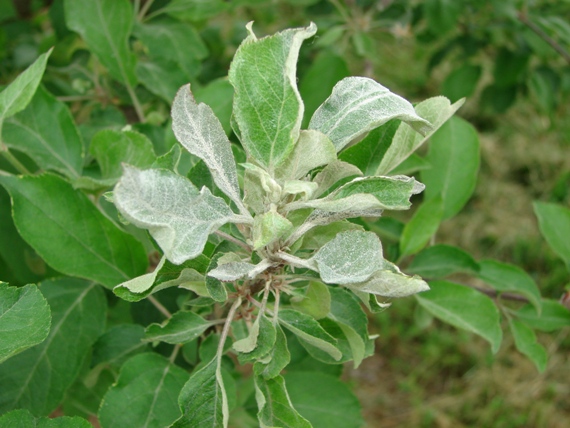Managing Apple Powdery Mildew

It’s July in Wisconsin, which means the humidity is up and if you have a history of powdery mildew in your orchard you may be observing secondary infections. The secondary infections can continue to produce more and more spores, and therefore your summer spray program should include control options for powdery mildew. The disease can result in defoliation, reduced fruit set, and reduced yield and quality.
Pathogen biology
The powdery mildew pathogen, Podosphaera leucotricha, overwinters in buds and as the buds break in the spring the fungus can spread and sporulate on leaf tissues. However, due to the very cold temperatures we typically experience in Wisconsin, buds harboring the pathogen may be killed off when cold temperatures persist through the winter months. Therefore, we commonly see powdery mildew infections following mild winters when the pathogen has an increased chance for survival.
Infected buds typically open a little later than healthy buds, meaning there is susceptible tissue available for infection when spores are released. There is a strong link between apple phenology and powdery mildew infections, where warm weather that promotes growth of apple shoots in the spring is also conducive to powdery mildew symptom development.
Conducive conditions
The powdery mildew fungus thrives in high humidity (>90%) and warm temperatures (optimum 66-72°F). Temperatures below 50°F and over 85°F can limit the germination of the fungus. In the spring, primary infections arise from buds where the fungus overwintered, and in the summer, secondary infections on leaves occur following movement of the spores from shoot strikes with primary infections. Unlike the apple scab pathogen, which requires rain for spore dispersal, powdery mildew does not require free water for germination and conidia (spores) are wind-blown from primary infections. During very rainy seasons powdery mildew infections may be low as these conditions do not favor the pathogen. If your foliage remains wet for extended periods of time it is unlikely that you will see powdery mildew develop. Alternatively, if we experience prolonged warm periods and no rainfall, powdery mildew infections are more likely to occur.
Management
Cultivar susceptibility. Select cultivars with resistance to powdery mildew. For a list of cultivars that are resistant or susceptible to powdery mildew check out this resource from Cornell University compiled from various works.
Cultural. Removal of inoculum with dormant pruning can be challenging due to the lack of visible symptoms during this period. When primary infections are visible in the spring, removal of infected shoots is still not often feasible. This practice may be most appropriate for young trees with low numbers of infections.
Conventional fungicides. Despite their differences in biology, many of the fungicides used to manage apple scab early in the season also have efficacy against powdery mildew (i.e., sulfur and FRAC 3 fungicides). Sulfur is effective against powdery mildew in apple, however phytotoxicity can occur when it is applied in high temperatures (>80°F). Protectant fungicides such as sulfur are a great early season option. Sulfur is also registered for organic production systems.
A strategy to consider as you battle other fungal diseases in your orchard is to use the FRAC 3 fungicides earlier in the season; these chemistries are highly effective against powdery mildew and are medium risk for fungicide resistance development. Saving fungicides from FRAC groups 7 and 11 until later in the season when you are managing summer rots and sooty blotch & flyspeck is another consideration as these chemistries work well for this group of diseases. Regardless of the chemistries you select for your orchard it is imperative that you rotate different FRAC groups throughout the season and avoid back-to-back applications of fungicides from the same FRAC group.
Fungicide applications should begin at tight cluster and continue through midsummer once shoot growth ends. Application intervals are shorter (7-10 days) during the early season following tight cluster and following bloom (post-bloom) these intervals are slightly longer (12-14 days).
Organic control products. The use of powdery mildew resistant cultivars is the first line of defense for organic apple production. Sulfur remains one of the most effective products for powdery mildew control in organic apple orchards. However, there are other OMRI-listed chemistries available such as Double Nickel LC and Serenade Opti; both contain a Bacillus sp. active ingredient. In general, OMRI-listed fungicides perform best in low disease pressure situations and some require frequent re-applications. Organic fungicide applications should also begin at tight cluster and continue into midsummer.
*Mention of a product is not an endorsement. The label is the law.
This article was posted in Apples, Disease and tagged apple powdery mildew, Apples, disease, Leslie Holland, Powdery mildew.
